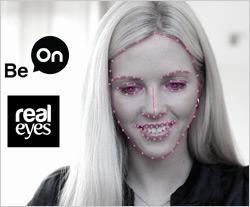How Do You Feel About This: AOL Enables Brands To Track Users' Unconscious Emotions, In Real-Time
- by Joe Mandese @mp_joemandese, June 14, 2013

In a move that ups the ante for real-time media measurement, AOL today will unveil a new platform that enables brands to measure not just whether people are exposed to or even see their content, but how they actually feel about it. The platform, which is being introduced by fledgling AOL branded entertainment unit Be On, utilizes users’ own webcams to read their facial expressions while watching a brand’s video content in order to understand what their unconscious feelings are while exposed to the brand’s messages.
The platform is being powered by Realeyes, a tech firm that has figured out an economical way of utilizing “computer vision to read faces and measure human emotion” via common webcams on users' PCs, tablets and smartphones, and initially will only track the faces and emotions of users participating into opt-in consumer panels operated by CINT and Toluna, but Be On CEO René Rechtman says AOL is already considering ways it could deploy the technology to track the emotional sentiment of its general users who want to opt into it.
The initial goal, he says, is to improve engagement levels that users have with brands running video content on AOL, but over time he says it could be used to improve the overall user experience with any AOL or brand content.
“It has always been very clear that content that has a strong emotional component has a much greater engagement and consumer response. We always knew that, but we didn’t have the science to execute it,” Rechtman explains, adding: “Now we have the technology and the science to measure how content affects people emotionally.”
AOL’s program is the latest in a rapid progression of so-called neuromarketing research applications that have emerged over the past half dozen years as new forms of biometric measurement technologies have enabled neuroscientists to develop methods for measuring the unconscious responses that consumers have to media, advertising and other forms of marketing -- even what people are feeling when they’re in stores looking at products and offers on shelves. Such neuromarketing initiatives have been a major focus on Madison Avenue, including the Advertising Research Foundation, which gave ample discussion to it during last week’s Audience Measurement conference in New York.
But coincidental developments in technology -- especially the ubiquitous distribution of webcams in personal media devices -- have created the opportunity to scale such tracking and to do it in real-time. Recently, Sticky, a company that Procter & Gamble encouraged to develop a method for using webcams to track users' eye movements to verify whether consumers are actually looking at ads or other brand content, introduced a panel capable of measuring it among hundreds of thousands of users in real-time.
As significant as eye-tracking is, AOL’s Rechtman says emotional tracking is the next logical progression, because the goal of media content -- especially the kind of “native” brand content AOL’s fledgling Be On unit is developing -- is to influence the eyes that are on it.



Be careful what you wish for.
Someone needs to draw a line here about: 1) what's in good taste, 2) when you need to use your own intelligence (remember that stuff inside the heads human beings before we discovered big data?), and 3) what constitutes an invasion of privacy.
This type of tactic is not necessary unless we value profit way above human relationship...and that seems to be where we're headed.
The opt-in part of this is fine- if people want to be monitored and are aware that it is happening then good for AOL. This technology could certainly be useful to advertisers in determining sentiment around their spots.
However, if an advertiser is looking at me through my webcam and I haven't explicitly given permission to do so then this is a new level of creepy. It's bad enough they already know my age, gender, location and device, they shouldn't get to watch me ignore their ad too.
I wonder if AOL accounts for people who suffer from B__chy resting face? http://www.youtube.com/watch?v=3v98CPXNiSk
Very "Clockwork Orange." Nice one, AOL.
As an industry we need to move from standard survey based research like DL and Vizu to improve brand research online. Now that most users have webcams on their phones, tablets and PC's, this methodology will help brands get real time or close to real time input on brand research without having publishers give away impressions to measure brand impact.
At the end of the day, the best way to do brand research is to get a sense of someone's real emotion, interest and connection to the ad/brand experience. This research method is not new, it has been helping BIG brands for several years and is proven to be successful. Glad to see it become more mainstream. Kudos to AOL.
If our current government regime can spy on our phones and Internet, what's the big deal?
The opt-in part is *not* fine. Almost nobody makes considered decisions on the internet, and they couldn't if they wanted to because there are not enough hours in the day to carefully read and analyze all the contracts that you allegedly agree by just using the internet normally. Also, AOL know this type of tech is a major reason why the xbone is in trouble, right? Ceiling cat is watching you